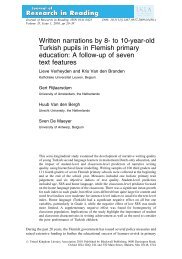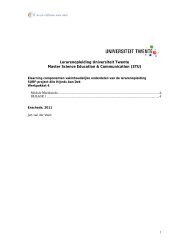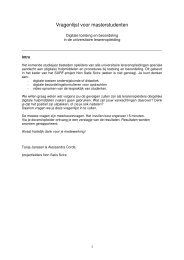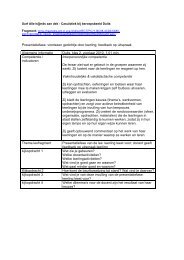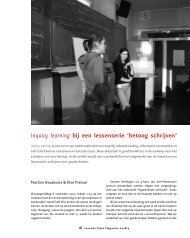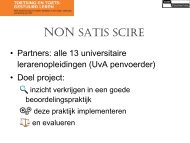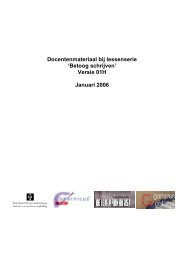Adaptivity in reading literary texts;
Adaptivity in reading literary texts;
Adaptivity in reading literary texts;
You also want an ePaper? Increase the reach of your titles
YUMPU automatically turns print PDFs into web optimized ePapers that Google loves.
Flexibility <strong>in</strong> read<strong>in</strong>g <strong>literary</strong> <strong>texts</strong> -9-<br />
- an <strong>in</strong>crease at the beg<strong>in</strong>n<strong>in</strong>g, followed by a decl<strong>in</strong>e towards the end of the read<strong>in</strong>g<br />
process.<br />
Some read<strong>in</strong>g activities (e.g., ‘analyz<strong>in</strong>g’) are represented by straight horizontal l<strong>in</strong>es. In these<br />
cases, the mean probability of occurrence of the activity rema<strong>in</strong>s constant over the read<strong>in</strong>g<br />
process as a whole. No change over the read<strong>in</strong>g process was observed.<br />
Other read<strong>in</strong>g activities show a pattern of gradual <strong>in</strong>crease (e.g., ‘problem detect<strong>in</strong>g’).<br />
At the beg<strong>in</strong>n<strong>in</strong>g of the read<strong>in</strong>g process, the probability of occurrence of problem detect<strong>in</strong>g is<br />
less than 10%. Student-readers tend to detect relatively few problems when read<strong>in</strong>g the first<br />
few story fragments. As the story read<strong>in</strong>g progresses, the probability of occurrence <strong>in</strong>creases.<br />
At the end of the read<strong>in</strong>g process, problem detect<strong>in</strong>g reaches a peak (about 20 %). Apparently,<br />
students experience relatively many <strong>in</strong>terpretation problems towards the end of the story.<br />
The third pattern can be illustrated by ‘associat<strong>in</strong>g’. This activity significantly decl<strong>in</strong>es<br />
over the course of the read<strong>in</strong>g process. At the start of the read<strong>in</strong>g process, when students are<br />
read<strong>in</strong>g the story’s title and the first few fragments, they provide relatively many personal<br />
associations <strong>in</strong> response to the story. As the read<strong>in</strong>g progresses, fewer associations are given.<br />
The probability of occurrence drops from 10 – 20% at the start to less than 5% at the end of<br />
the read<strong>in</strong>g process.<br />
The f<strong>in</strong>al pattern is illustrated by strong readers’ emotional responses. At the<br />
beg<strong>in</strong>n<strong>in</strong>g of the read<strong>in</strong>g process, there is a probability of about 5% that strong readers<br />
provide emotional responses to the story. This probability <strong>in</strong>creases significantly dur<strong>in</strong>g<br />
read<strong>in</strong>g. For story fragment 9 the probability of occurrence has been doubled (13%). From<br />
this po<strong>in</strong>t on, the chance of emotional responses to occur dim<strong>in</strong>ishes aga<strong>in</strong>, dropp<strong>in</strong>g to about<br />
8%. Apparently, strong readers tend to provide the most emotional responses when they are<br />
read<strong>in</strong>g the middle part of stories, the part where ‘the true action’ takes place.<br />
In sum, readers tend to change the configuration of their read<strong>in</strong>g activities over time.<br />
The mean probability of occurrence fluctuates over moments <strong>in</strong> the read<strong>in</strong>g process for six out<br />
of eight read<strong>in</strong>g activities; retell<strong>in</strong>g, <strong>in</strong>ferenc<strong>in</strong>g, problem detect<strong>in</strong>g, associat<strong>in</strong>g, evaluat<strong>in</strong>g<br />
and emotional respond<strong>in</strong>g. For two activities (analyz<strong>in</strong>g and metacognitive respond<strong>in</strong>g) no<br />
changes over the course of the read<strong>in</strong>g process were observed.<br />
Do strong readers more often change their activities dur<strong>in</strong>g read<strong>in</strong>g than their weaker peers?<br />
Our second research question (2a) <strong>in</strong>volves a comparison between weak (W) and strong (S)<br />
readers, regard<strong>in</strong>g changes <strong>in</strong> their read<strong>in</strong>g activities dur<strong>in</strong>g read<strong>in</strong>g. The comparison can be<br />
made from two different perspectives; <strong>in</strong> terms of differences <strong>in</strong> occurrence, and <strong>in</strong> terms of<br />
the pattern of development of the activity over time.<br />
Figure 1 shows that for analyz<strong>in</strong>g, the l<strong>in</strong>es for weak and strong readers co<strong>in</strong>cide,<br />
form<strong>in</strong>g one straight horizontal l<strong>in</strong>e. This <strong>in</strong>dicates that weak readers engage <strong>in</strong> analyz<strong>in</strong>g as<br />
often as strong readers, and that <strong>in</strong> both groups the occurrence of analyz<strong>in</strong>g rema<strong>in</strong>s constant<br />
over the read<strong>in</strong>g process.<br />
For problem detect<strong>in</strong>g, associat<strong>in</strong>g and metacognitive respond<strong>in</strong>g, the l<strong>in</strong>es of weak<br />
and strong readers are (almost) parallel. This <strong>in</strong>dicates a similar pattern of development for<br />
both groups; an <strong>in</strong>crease of problem detect<strong>in</strong>g, a decl<strong>in</strong>e of associat<strong>in</strong>g, and a stable pattern of<br />
metacognitive responses throughout their read<strong>in</strong>g of a story. However, the extent to which<br />
weak and strong readers engage <strong>in</strong> these activities differs. In general, strong readers engage <strong>in</strong><br />
these activities more often than weak readers, throughout the read<strong>in</strong>g process.<br />
The panels of the rema<strong>in</strong><strong>in</strong>g read<strong>in</strong>g activities (retell<strong>in</strong>g, <strong>in</strong>ferenc<strong>in</strong>g, evaluat<strong>in</strong>g, and<br />
emotional respond<strong>in</strong>g) show differences <strong>in</strong> occurrence and different patterns of development<br />
for weak and strong readers. For example, compared to strong readers, weak readers provide<br />
many retell<strong>in</strong>gs of the story content dur<strong>in</strong>g read<strong>in</strong>g. Their mean pattern of response does not






